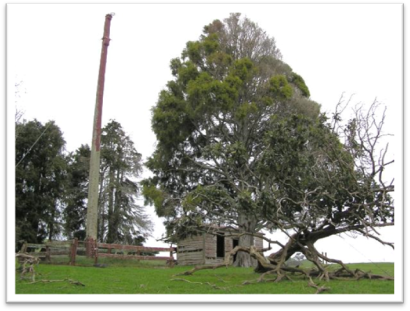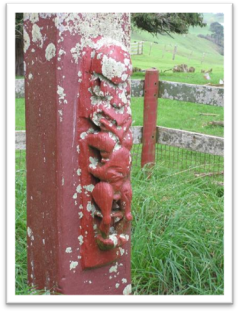HH-34: Motai Niu Pole (T15/193)

Date of Photograph: 29/07/2008
Location and Zoning Information | |
Address |
Kakoahu Road, Kuranui |
Current Owner |
H.H. Pate, R & L Kinred & Others |
Legal Description |
Te Hanga A11 Block |
Zoning |
General Rural Zone |
Valuation Number |
0541133600 |
Google Maps Link |
|
Architecture | |
Date of Construction |
1865 (according to local tradition but no exact date could be established) |
Materials |
Totara |
Architecture/Engineer/Builder |
|
Condition |
Good. The wire stays have were replaced or tightened recently. The niu pole was conserved in the 1980s. At that time an archaeological investigation was carried out at the site to gather additional information about the pole. (The report has been added to this record as additional information). The pole was 14 metres high when assessed for conservation in the early 1980s. 2.50 metres were below ground and deteriorated. 1.25m of the pole which was in the ground broke off when it was being removed for treatment. The base dimensions of the pole are 43 x 38 cm. An iron hook is located around the top of the pole. It is believed the hook held a cross timber or spar in place near the top of the pole. The base of the pole in fenced. Local history suggests there was a garden in this zone at the base of the pole. (A paper is attached that describes the pole and the treatments used to stabilise the pole). A small derelict house is located near the pole. The back of the house has collapsed and is open to the weather, but the main structure is still stable. |
Original Site Recommendation |
Cowan, J (1983) The New Zealand Wars Vol 1. NZAA Site Record T15/193. Martelletti, N (1996) Kuranui Historic Pole NZ Historic Places Trust Magazine. Peters, K (1990) Conservation of a Niu Pole at Kuranui and Excavation Report 1980. Stokes, E (1980) Pai Marire The Niu at Kuranui (Occasional paper no 6) |
Current Use |
|
Statement of Significance | |
(1, 3, and 4) Historical the niu pole relates to early New Zealand History and the development of a new religion (Pai Marire) within New Zealand. The site has research potential as an archaeological site and is both a settlement site and religious site. (5) Important to Tangata whenua as a traditional, historical, religious, commemorative, and educational symbol. The niu was associated with the king movement but the Kuranui pole is specifically noted as associated with Ngati Raukawa and the hapu Ngati Motai. (7) Potential for Public Education as part of a heritage trail or through school visits. (11) Rare, the only niu in SWD. (13) Integrity of the niu is high, it is on its original site and has a relationship with the modified landscape of the setting. The pole has been conserved. District Plan RulesDemolition – NC – Refer to GRUZ-R5 Additions/ Alterations - NC – Refer to GRUZ-R5 Re-use/ Change of Use - NC – Refer to GRUZ-R5. Internal Changes - Not applicable Relocation- NC – Refer to GRUZ-R5 Disturbance of the site surface/ earthworks - Note: An archaeological site is any place that was associated with human activity prior to 1900 and is or may be able, through investigation using archaeological methods, to provide evidence relating to the history of New Zealand (Historic Places Act 1993, Section 2). All archaeological sites are protected under the Heritage New Zealand Pouhere Taonga Act 2014 and approval must be obtained from Heritage New Zealand prior to destroying, damaging or modifying an archaeological site. Accordingly, where this site on which a building is located is an ‘archaeological site’ and the building is to be repaired, added to, relocated or demolished and this involves disturbance of the surface and/or sub-surface of the site, approval from Heritage New Zealand is required. | |
History | |
The Motai Niu Pole or worship pole at Kuranui marks the presence of the Pai Marire or Hauhau movement. The Pai Marire religion was practiced in the area in the late 19th century. The Pai Marire faith was founded by Te Ua Horopapera Haumene of Taranaki. Te Ua’s guiding spirit was Atua Pai Marire, the “good and peaceful god”. The niu was the central symbol of worship and each tribe that converted to the new religion erected a niu pole under the direction of Te Ua or his sub-priests. Pai Marire was adopted by the Maori King. By the end of 1865s a niu stood in every large village from Taranaki to the Bay of Plenty (except Arawa) and from the north of Wellington to the Waikato frontier. Several times each day the Hauhau gathered at the foot of the niu pole for worship. They marched in procession round and round the pole chanting in chorus the Pai Marire incantations taught by the prophet. Kuranui was a gathering point for Hauhau in the region. The niu pole at Kuranui belongs to Ngati Motai, a hapu of Ngati Raukawa. Local tradition indicates the pole at Kuranui was erected in 1865. The Motai niu pole was made from a totara tree felled near Katikati. A human figure with a birds head, ‘Rupe’, is carved near the base of the pole. Rupe represented a dove, the biblical symbol of the Holy Spirit in Pai Marire religion. Rupe was also one of the ancestors associated with Maui. In the early 1870’s Te Kooti was regarded as a leader of the movement and during military pursuit from Taupo he retreated from Tapapa to Kuranui and was sheltered. According to local tradition Te Kooti’s flag, Te Whepu (the whip) once flew from the Kuranui niu pole. A small caretakers house is located near the pole. The last guardian of the pole was Mokai Te Pakaru. He died in 1972 and the site has been abandoned. The archaeological report on the pole conservation notes that according to Mrs Rangipukea Kindred, who lived at Kuranui in her youth, there was a settlement at the site. These are indicated by the line of trees and tree stumps and a meeting house. | |
Additional Photographs

